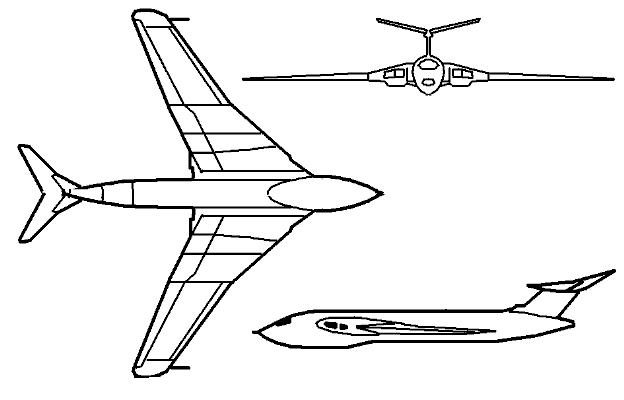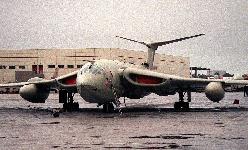Victor
The third of the RAF's trio of V-bombers, the Handley Page Victor flew for the first time on 24 December 1952, and the first production B.Mk.1 flew on February 1, 1956. The Victor B.1 and B.1A, the latter having modified equipment and ECM in the rear fuselage, subsequently entered service with Nos. 10, 15, 55 and 57 Squadrons of No. 3 Group R.A.F. Bomber Command, anti a photo-reconnaissance version, the B.(P.R.)1, was delivered to the R.A.F.'s Photographic Reconnaissance Unit at Wytan. Carrying a crew of five, the Victor B.1 and B.1A cam accommodate a variety of conventional or nuclear free falling weapons in a large weapons bay. The Victor B.1 has flown at speeds only marginally below Mach 1.0 at altitudes above 50,000 feet, and could exceed Mach 1.0 in a shallow dive. Formation of the planned total of four Victor B.1 squadrons was completed in 1960.
The first Victor B.2 flew on 20 February 1959, and a reconnaissance version using a variety of advanced techniques was designated Victor B.(P.R.)2. The Victor B.2, which entered service with No. 3 Group of RAF Bomber Command early in 1962, the first squadron to receive this long-range medium bomber being No. 139. The first Victor B.2 unit to become operational with the Avro Blue Steel Mk. 1 rocket-propelled, supersonic-cruise stand-off weapon was No. 27 Squadron. By comparison with the B.Mk. 1, the Victor B.2 had substantially increased wing span, enlarged intakes to feed the appreciably more powerful Conway turbojets, and a retractable scoop on each side of the rear fuselage to supply ram air to two turbo-alternators. Work on the Handley Page Victor heavy bomber started in 1945, and in February 1946 the draft design bomber received the HP 80. However, due to the revision of the guidance of the Air Force tactical and technical requirements, in the next year, the project underwent substantial revision. The changes were primarily the wing, which resulted in the distinctive crescent shape. The theory of sickle wings was developed by German aviation specialists firms Arado and Blohm and Voss. This gave the wing a number of significant advantages and allowed puttin four engines its thick root section. In accordance with calculations, the aircraft had records for its time characteristics: a cruising flight speed of 925 km / h, and a range of 5630 km with a bomb load of 4.5 tonnes. In the summer of 1948 came an order to build two prototypes. In mid-1952 the company received an order from the Ministry of Aviation for the construction of the first series of 25 Victor B. Mk.1 aircraft. This is the official name of the bomber announced on 02 January 1953. The first of two bomber prototypes flew 17 minutes on, December 24 1952, and the second - 11 September 1954. In the summer of 1953, during the coronation, the plane was first shown to the public. In the same year the aircraft participated in the air show in Faranboro. Flight tests soon revealed a number of shortcomings of the machine. Unable to verify the design characteristics, there began feverish work to improve the "Victor". On 05 February 1954 a speed of Mach 0.925 was reached in level flight at a height of 13716 meters. But on 14 July 1954 the first flight of the prototype took place at low altitude, and ended in disaster. This event slowed the progress of work. Official tests of the aircraft continued only in March 1955. By the time the company's designers had managed to eliminate almost all the defects and shortcomings. On 01 February 1956 the first production bomber took off. It was somewhat different from the experimental machines. The fuselage was lengthened 1.02 meters, with an increased height of the keel. Its design has been strengthened (due to the destruction of the keel attachment site disaster occurred). On the plane installed Armstrong-Siddeley "Sapphire-7" engines with a thrust 4990 kgf. The price per serial bomber reached 400,000 pounds. The plane made by the normal aerodynamic scheme with srederaspolozhennym wing. circular cross-section fuselage consists of three main parts. In front is pressurized cabin crew and equipment compartment. Seats pilots equipped with a catapult. The other members of the crew in an emergency leave the aircraft through a side door. At the root of the crescent wing has four turbojet. The tail unit - T-shape. Main landing gear with four-wheel carts are cleaned in the center section. In the middle part of the fuselage is a compartment of arms. It could be placed one nuclear bomb weighing 4540 kg or a different combination of conventional bombs the total weight of up to 10,000 kg. Victor B Mk1 was quite successful machine and is not inferior to the characteristics (except flight range) the best Soviet and American strategic bombers and 3M B-52B. Such high performance was achieved thanks to the British a good aerodynamics and powerful engines Bristol "Sapphire" 7 Mk.200. On the plane we installed the most modern equipment. For example, navigation and bomber H2S system ensures the accuracy of the output to the target within 450 meters. However, the aircraft did not have defensive weapons, making it vulnerable to attack by air defense fighters. The first nine production aircraft arrived v1957 year in the 232-th group of flight crew training, which was organized by the retraining of pilots previously flew on other types of bombers. In 1958, at the "Victoria" completely rearmed the first squadron of the 3rd Bomb Group RAF. The initial order is increased to 50 units. It was agreed that the last 24 cars to be built in Mk1A version. These aircraft differed more sophisticated and varied equipment REB. By this time, the geopolitical situation in the world has changed. British Empire no longer existed. We changed and the problem for the British strategic bombers, the main purpose of which was the nuclear strikes on the cities of the USSR. It was planned that the crew should, if necessary, reset the high-altitude nuclear and thermonuclear bombs on the objects located in the European part of the Soviet Union. The rapid increase in the combat capabilities of fighter-interceptors and anti-aircraft missiles of Soviet troops forced the British defense specialists to seek ways to enhance the effectiveness of "Victor". The company's specialists have developed a program of modernization of serial bomber calls for the work in two phases. In the first phase planned to equip new aircraft turbojets "Sapphire» ASSa 9, while the second - was supposed to develop a more advanced modification of the HP machine 104. However, for a number of reasons, this option was rejected. It was a compromise solution. So there was an option - Victor B Mk2. He was to be the bearer of a cruise missile "Blue Steel» Mk1 with a range of start-up to 320 km, which from March 1956 been developing weapons systems department of the company Avro. On arming the missile arrived in 1960. Other ways to improve the aircraft at the lowest cost and simply did not have. The rocket was suspended in the semi-flush position in the bomb bay. Start it was carried out from a height of 15240 m. The jet engine was switched after four seconds after the reset and the rocket at a speed of M = 2.5 rushed to the goal. The control system provides accuracy of 92 meters, which was better precision bombing (640 m). The term "Blue Steel" had to give way to the US ballistic missile air-launched AGM-87A «Sky Bolt." This two-stage solid propellant missile with a launch weight of 5100 kg should have a 1,600 km range and a nuclear warhead capacity of 2 Mt. But in 1962, Americans turned this rocket works. December 1960 vol 631 c846 846§33. Mr. Emrys Hughes asked the Minister of Aviation what is the cost of the latest type of Victor Bomber.§Mr. Thorneycroft About £1 million. By 1965 the Bomber Command front line had received its full complement of Victor 2s, and re-equipment with Vulcan 2s had entered its final phase. Until they are run down early in the 1970s it was ther intention that British V-bombers, except those required for commitments outside Europe, should form a major component of the Atlantic nuclear force which the UK had proposed to NATO allies. the B.2 Victor, fitted with the Conway engines, which have a much higher thrust than the engines of the Mark I. A great deal of harm was done to Handley Page Aircraft Limited by the delay in awarding the Victor bomber tanker conversion contract; The contract could not be let until the Government were assured that Handley Page design and design capability could handle the contract. The pre-studies for the design were all covered by contract, but we had not received the final costs from Handley Page when the receiver went in. Handley Page Aircraft Limited was in liquidation in October 1969, but at that period contingency planning had taken place, and Hawker Siddeley had been questioned about the possibility of its taking over. Therefore, when Handley Page Aircraft Limited went into liquidation these contingency plans were made with Hawker Siddeley and there should be the minimum delay because of the transfer to Hawker Siddeley. On 27 February 1970 Handley Page Aircraft Ltd. told the Department that they were no longer able to fulfil their contracts for R.A.F. work. Urgent action was necessary and Hawker Siddeley Aviation Ltd. was asked to take over the contracts immediately. The choice of firm was determined by the Government's long-standing policy of placing major airframe design work on either H.S.A. or the British Aviation Corporation, by H.S.A.'s understanding of this task, and by the likelihood of their being able to keep the Victor design team together. Tenders were not practicable in the circumstances. Tthe total research development and production cost of the Valiant tanker force was £67 million. This was for the total force as originally planned.


| Specifications | |
|---|---|
| Primary Function: | medium bomber |
| Contractor: | |
| Power Plant: | B.1 - Four Bristol Siddeley Sapphire 202 turbojets B.2 - Four Rolls-Royce Conway R.Co.11 turbojet |
| Thrust: |
B.2 - 11,000 lbst B.2 - 17,250 lbst |
| Length: |
B.2 - 114 ft. 11 in. B.2 - 114 ft. 11 in. |
| Height: |
B.2 - 28 ft. 11 in. B.2 - 30 ft. 1i in. |
| Wingspan: |
B.2 - 110 ft. B.2 - 120 ft. |
| Speed: |
B.1 - Max. speed, 650 mph. at 40,000-50,000 ft.(Mach 0.98) B.1 - Cruising, 560-620 mph. at 30,000 ft. B.2 - Max. speed, 650 m.p.h. at 40,000-50,000 ft. (Mach 0.98) B.2 - Cruising, 560-620 m.p.h. at 35,000-45,000 ft. |
| Ceiling: |
B.2 - 55,000 ft. B.2 - 60,000 ft. |
| Weight loaded: |
B.2 - 150,000-180,000 lb. B.2 - 200,000 lb. |
| Maximum Takeoff Weight: |
B.2 - B.2 - |
| Range: |
B.2 - 3,500 miles [internal tankage] B.2 - |
| Armament: | |
| Crew: | |
| Unit Cost: | |
| Deployed: |
No 10 Squadron No 15 Squadron No 55 Squadron No 57 Squadron No 214 Squadron No 543 Squadron No 232 OCU RAF Cottesmore RAF Gaydon RAF Honington RAF Marham RAF Wyton |
| Inventory: | |

Victor K2 in 55 Squadron markings
|
NEWSLETTER
|
| Join the GlobalSecurity.org mailing list |
|
|
|

